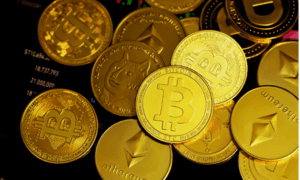The interplay between the Federal Reserve’s monetary policy and trade tariff implementation has already had significant implications for gold prices in 2025, and that impact is likely to continue. The price of gold reached a record high of $3,200 on March 31, and many analysts expect global economic uncertainty to keep demand strong and continue to drive price increases.
In a recent statement examining its prediction that gold prices could reach $4,200, precious metals firm Lear Capital emphasized the role of the Fed interest rate policy and U.S. tariffs in driving investors to gold as a safe-haven asset.
“On March 19, 2025, the Federal Reserve held interest rates steady at 4.25% to 4.5% with Chair Jerome Powell noting that higher inflation expectations stem partly from tariffs, while weaker growth and rising recession forecasts have introduced new economic uncertainty,” said the statement. “With inflation risks persisting and economic growth slowing, investors are increasingly turning to gold as a hedge against uncertainty and a safeguard against the eroding value of the dollar.”
Federal Reserve Policy Direction
The Fed’s current monetary policy stance reflects a challenging environment shaped by conflicting economic signals. On one hand, inflation remains a concern, which would normally justify keeping interest rates elevated. On the other hand, signs of slowing economic growth typically prompt rate cuts to stimulate demand. Balancing these opposing pressures complicates the Fed’s decision-making process. In periods of uncertainty such as this, investors may look to gold for stability.
Historically, gold has performed well during periods of low or declining interest rates. When interest rates fall, the opportunity cost of holding nonyielding assets like gold decreases, making the precious metal more attractive to investors seeking stable stores of value.
Lear Capital’s DeMeritt has often emphasized the relationship between interest rates and gold performance. “Interest rates are going to come down, which is usually very good for the gold market,” he says.
And while the Federal Reserve adjusts its monetary policy decisions, other central banks appear to be hedging against potential economic instability by increasing their gold reserves. These actions serve as a powerful market signal that may influence retail and institutional investor behavior throughout the remainder of 2025.
The World Gold Council reports that central banks purchased over 1,000 tonnes of gold for the third consecutive year in 2024, with buying accelerating sharply in the fourth quarter to 333 tonnes. The buying trend has persisted in 2025, with the World Gold Council noting continued net purchases of 18 tonnes in January, followed by 24 tonnes in February.
Tariff Implementation and Inflationary Pressures
The implementation of tariffs by the Donald Trump administration has introduced additional complexity into the economy. According to a Tax Foundationanalysis, “President Trump’s 25% tariffs on Canada and Mexico is estimated to reduce long-run GDP by 0.2%, reduce hours worked by 223,000 full-time equivalent jobs, and reduce after-tax incomes by an average of 0.6% —before accounting for foreign retaliation.”
Tariffs could thus have significant implications for inflation and economic growth, creating a complex set of conditions that typically favor gold.
“There’re concerns that some of the (economic) growth may come down because of the policies and tariffs that the current administration is looking to implement,” said Phillip Streible, chief market strategist at Blue Line Futures, in an interview with Reuters. “So when you’ve got higher inflation and lower growth, stagflation becomes the economic theme. Gold tends to work very well in that particular environment.”
The scope of these tariff implementations is extensive. On Feb. 1, 2025, President Trump signed executive orders to impose 25% tariffs on Canada and Mexico and 10% tariffs on China using International Emergency Economic Powers Act authority. Subsequently, on Feb. 10, 2025, he signed proclamations to expand existing tariffs on steel and aluminum, ending all exemptions and raising the aluminum tariff rate to 25%.
Trump’s most recent wave of tariffs has contributed to inflationary concerns while simultaneously raising questions about economic growth prospects and potential trade wars — a combination that’s historically benefited gold prices by driving up safe-haven demand for bullion as a hedge against price pressures and geopolitical uncertainty.
The combined influence of Federal Reserve policy and tariff implementation has triggered notable movements in gold prices. Immediately following Trump’s announcement of the new tariff framework, gold experienced significant upward momentum, breaking above $2,900 per ounce for the first time. The momentum continued to carry the price over $3,100 on March 31.
This price movement demonstrates how quickly gold markets can respond to policy changes that create economic uncertainty. The anticipation of future tariffs, along with uncertainty about their economic impact, has contributed to a risk-off sentiment that typically benefits safe-haven assets like gold. The potential for stagflation — characterized by high inflation and slow economic growth — creates particularly favorable conditions for gold as both an inflation hedge and a safe-haven asset during periods of economic uncertainty.
Outlook for Remainder of 2025
Looking ahead, the interplay between monetary policy and trade policy will likely continue to influence gold prices throughout 2025. The World Gold Council’s analysis suggests that “central banks will remain an ‘important part of the puzzle’ this year,” noting that central bank demand will continue to “provide a boost” to gold, should it remain at a healthy level.
The consensus among market analysts suggests that gold prices could continue their upward trajectory in 2025, potentially reaching the $3,500 range or higher. Lear Capital is optimistic.
“The convergence of financial challenges we’re witnessing today creates the perfect storm for gold’s historic rally,” said Kevin DeMeritt. “With gold hitting $3,200 per ounce in mid-April, the economic headwinds we identified in our initial report are accelerating, potentially shortening the timeline to the $4,200 milestone.”
Other analysts agree. Macquarie Group now predicts gold will get to $3,500 at some point in the third quarter of 2025.
Investment Implications
For investors navigating the complex relation between Fed policy, tariffs, and the broader economic environment, several considerations are worth keeping in mind.
First, the timing of potential Federal Reserve rate cuts could significantly impact gold prices. Market expectations for rate cuts in 2025 have been shifting as inflation concerns persist, particularly given the inflationary impact of tariffs.
Second, the extent and implementation timeline of additional tariffs remain uncertain. Trump has announced plans for further tariffs on the European Union and signaled intentions to implement tariffs on auto imports, but the specific details and timing are still developing. These policy decisions could trigger additional market volatility that might benefit gold prices.
Given these factors, investors may want to consider gold’s role within a diversified portfolio. As Lear Capital advises, precious metals like gold can serve as a counterweight against economic turbulence and currency devaluation. The percentage allocation would depend on individual circumstances, risk tolerance, and investment objectives.



































